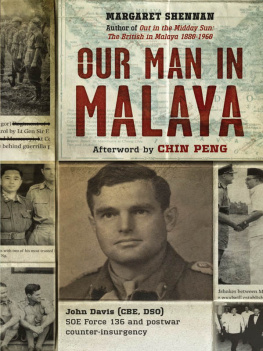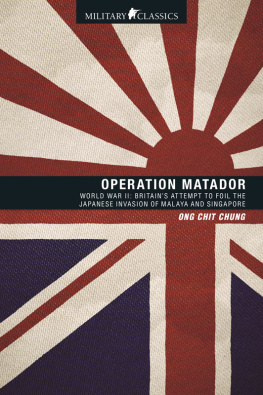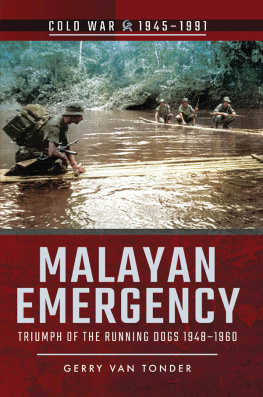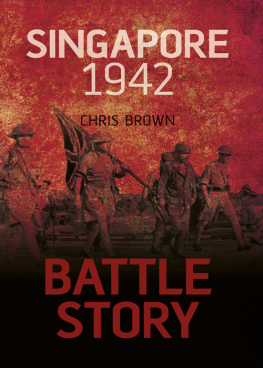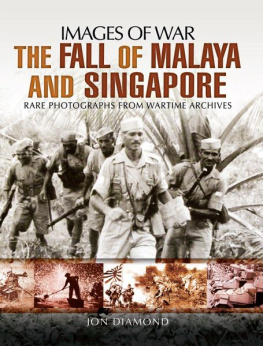Out in the Midday Sun
The British in Malay 1880-1960
Margaret Shennan
Monsoon Books
Singapore
Published in 2015
by Monsoon Books Pte Ltd
150 Ochard Road #07-02, Singapore 238841
www.monsoonbooks.com.sg
ISBN (paperback): 978-981-4625-31-9
ISBN (ebook): 978-981-4625-32-6
First published in 2000 by John Murray (Publishers), Ltd.
CopyrightMargaret Shennan, 2000
The moral right of the author has been asserted.
All rights reserved. No part of this publication may be reproduced, stored in a retrieval system, or transmitted, in any form or by any means without the prior written permission of the publisher, nor be otherwise circulated in any form of binding or cover other than that in which it is published and without a similar condition being imposed on the subsequent purchaser.
Cover design by Cover Kitchen.
Frontcover studio portrait of Edwin A. Brown, photographed in Singapore in 1903, courtesy Estate of Edwin A. Brown.
Out in the Midday Sun Margaret Shennan. All Rights Reserved, except where otherwise noted.
Contents
The author and publisher would like to thank the following for permission to reproduce illustrations: Plates 1, 2 and 3, Twentieth Century Impressions of British Malaya, 1908, pp.582, 585, 671; 4, 6, 15, 17, 18 and 28, J. A. S. Edington; 5, Norman Price; 7, 8, 10, 11 and 14, Gordon Snell; 9, Christopher Cannell; 13, 20 and 23, Ms Ray Forsyth; 21, Brian and Colin Kitching; 22, D. J. Anderson; 24, Derick Cullen; 25 and 30, family of John Davis; 26 and 29, H. P. Bryson Collection; 27, Miles Templer; 31, John Hembry; 32, Mrs Fenella Davis. Plates 12, 16 and 19 are taken from the authors collection.
The chapter endnotes for this book may be found online at: www.monsoonbooks.com.sg/citations/Out-in-the-Midday-Sun
In writing this book I have relied on the generous advice, information and goodwill of many people whose help I wish to acknowledge. In the first instance, my warmest thanks go to Ms Terry Barringer, librarian of the Royal Commonwealth Society Collection at Cambridge University, who gave me invaluable guidance and assistance, particularly on my numerous working visits to the library. I also thank Mr Lewis Hill, Director of the Centre for South-East Asian Studies at the University of Hull, Mr Michael Hughes at Rhodes House Library, Oxford, and the staff of the Imperial War Museum Archives, London, including Mr Peter Kent at the Photograph Archive. I am grateful to the staff and the Trustees of the Liddell Hart Centre for Military Archives at Kings College, London, for permission to quote from the Vlieland papers; to Dr Gareth Griffiths for advice and for permission to quote from the resources of the Oral History Archive of the British Empire and Commonwealth Museum, Bristol, archivist Mary Ingoldby. In addition, I thank the Syndics of Cambridge University Library for their permission to publish material from the Royal Commonwealth Societys collections; and the staff at Lancaster City Library and Lancashire County Services, Lancaster University Library and the Sydney Jones Library, University of Liverpool, for their assistance.
A number of people offered me private family papers, manuscripts and letters, and I am most grateful to them for providing hitherto unpublished material. In particular, my heartfelt thanks go to Ray Forsyth and John Soper for allowing me to make significant use of the unpublished works of their father, Mr J. R. P. Soper. I am similarly indebted to M. J. Gent, OBE, for offering me the unqualified use of Marian Gents manuscript; to Derick Cullen for use of his family collection of letters and other papers; to Jack warm of Adelaide for use of his fathers Changi Diary; also to Susan Tanner for lending me the copy of Captain Henry Malets War Diary and a rare commemorative booklet on the Convent School, Cameron Highlands; to Norman Price for allowing me to use his mothers Malayan Memories and other family papers; and to both Colin and Brian Kitching for permission to quote from their fathers work in the Royal Commonwealth Society Collection, and for kindly presenting me with a copy of the diary of Tom Kitching, Life and Death in Changi, published by Brian Kitching, while letting me quote freely from the text. I am grateful also to Geoffrey Barnes for permitting me to quote from his autobiography, Mostly Memories; similarly to Jonathan Sim with regard to Katharine Sims book, Malayan Landscape, and to Pelanduk Publications regarding Dato Mubin Sheppards biography of Tunku Abdul Rahman. I thank Suzanne, Duchess of St Albans, for clarifying some personal details and also for permission to quote from her autobiography, The Mimosa and the Mango (now part of a condensed version of her three-volume memoirs, Mangoes and Mimosa, published by Virago). Mary Elder was kind enough to lend me a copy of Gods Little Acre with its invaluable insight into the Emergency, and I thank John Edington for providing me with numerous personal items and for his constant advice and willingness to answer a stream of questions.
Many former residents of Malaysia offered photographs from their personal collections, with permission to publish them as illustrations, together with other memorabilia from the colonial period, and I thank them sincerely and regret that only a proportion could be incorporated in the book. I should like to record my thanks to Derek J. Anderson for permission to reproduce a drawing of Changi Gaol, formerly in the possession of his grandfather, Alexander Godfrey Donn, a prisoner-of-war in Singapore; Douglas Benton for a rare photograph of Guy Hutchinson; and Gordon Snell for full use of his family albums. Others to whom I owe thanks are listed in the acknowledgements to the illustrations.
Several people gave me valuable advice in the early stages of the project, in particular, A. J. S. Anderson of the Scottish Malaysian Association, Kenneth Barnes, Peggie Robertson, John Gullick, Kay Larsson and Professor Mary Turnbull. I am grateful to John Loch for putting me in touch with John Davis of Force 136. I also received valuable information in telephone and face-to-face conversations with ex-Malayans, and in letters and newspaper cuttings. In conclusion, I record my thanks to the Revd Derek Allton, John Anderson. Ron Armstrong, Ken Barnes, the late Colonel Christopher Barrett, Jette Barrett, Roger Barrett, Dermot Barton, QBE, Margaret Barton, Dr Erina Batt, Gordon D. Brown, Christina Browne, Christopher Cannell, Dr D. R. Clementi, Derick Cullen, John Davis, CBE, DSO, Anne Douglas, Robert W Duffton, Deirdre Edington, John A. S.Edington, Mary L. Elder, Ray Forsyth, Sir Leslie Froggatt, James Gilbert, D. M. Gold, Dulcie Gray, CBE, Ian Harness, Maureen Heath, Michael ]. Henebrey, Valerie Henebrey, Brian Hunt, Tom Kerr, Donald Macpherson, Margot Massie, John Menneer, G. T. M. de M.Morgan, MC, OBE, Edward Morris, Peter Morris, Harold Naysmith, Mrs Jane ODonovan, Dr Michael Pallister, J. R. Pippet, Norman Price, Anthony Pybus, Sheila Rawdiffe, Edward R. Read, Alastair Reid, James Robertson, MBE, Professor Peter Rowe, Elizabeth Scott, Catherine Small, Gordon Snell, Brian Stewart, CMG, Susan Tanner, Miles Templer, William W Vowler, Christopher Watkins, E. James Winchester, Simon Wright and Alexander Wylde. If there are any inadvertent omissions, I offer my sincere apologies.
Margaret Shennan
In the past century the British appear to have been driven by a compulsion to put into words their experiences and perceptions of life in the East. Malaya, in particular, has stimulated a mass of literature, both fiction and non-fiction. Many British expatriates wrote letters home or kept a diary to be turned later into a period memoir, with descriptions of events, people, the beauty of the tropical scenery, the trials and surprises of the climate. Travellers kept accounts of their journeys; journalists and writers found inspiration in Malayas exotic setting, its humdrum and quixotic characters, or the tragedies of a benign but flawed colonial regime. If the Raj boasts Rudyard Kipling, E. M. Forster and Paul Scott, Malaya has, among others, Joseph Conrad and Henry Fauconnier, Somerset Maugham, Anthony Burgess, Paul Theroux, J. G. Farrell, Neville Shute, Alan Sillitoe and Leslie Thomas. Alongside these are some less well-known raconteurs and observers: Isabella Bird and Emily Innes both underestimated, despite the sharp eye for detail of the one and the laconic humour of the other; governors Frank Swettenham and Hugh Clifford, and the official J. T. Thomson, who like Swettenham was a gifted artist and whose paintings of Malayan scenes have a directness akin to Lowrys pictures of industrial England. And more recently, in the twentieth century, civil servants such as Richard Winstedt, R. J. Wilkinson, Victor Purcell and J. M. Gullick have demonstrated their expert knowledge in contributions to academic scholarship.


